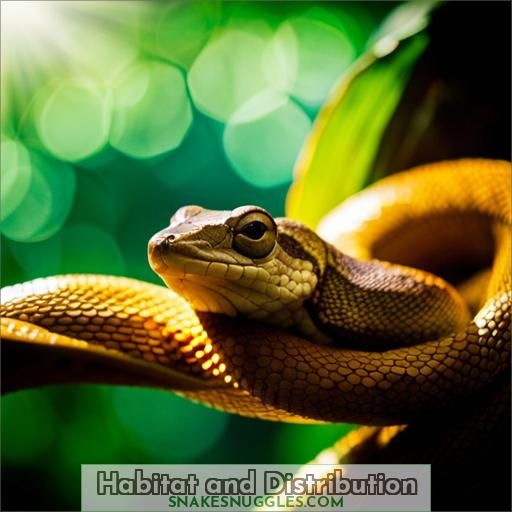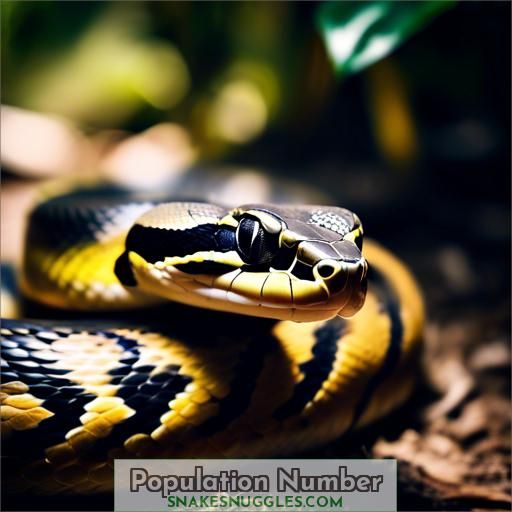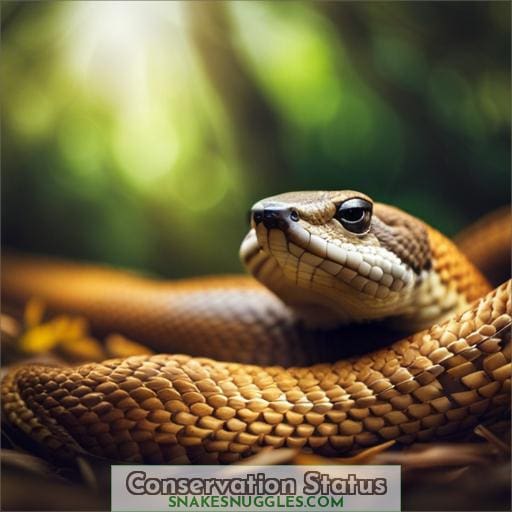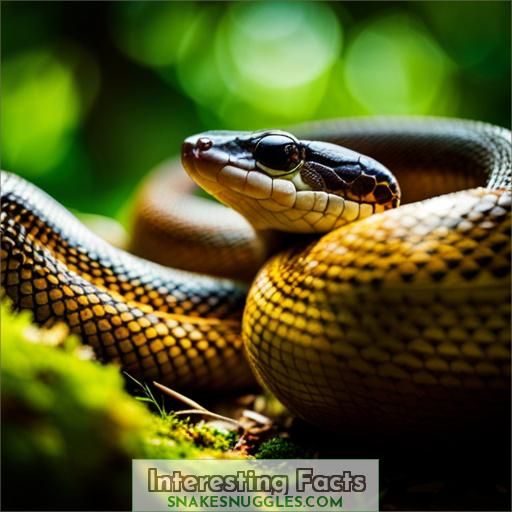This site is supported by our readers. We may earn a commission, at no cost to you, if you purchase through links.
Pythons are cosmopolitan creatures, inhabiting diverse environments across the globe, from the tropics of South and Southeast Asia to the subtropical regions of Florida. As an invasive species, they’ve significantly disrupted the Everglades ecosystem. Despite this, they’re listed as least concern by the IUCN.
You’ll find them in various habitats, thriving due to their adaptability and status as top predators. They’re fascinating for their size, unique adaptations, and interaction with humans.
By exploring further, you’ll uncover the intricate details of their behavior, conservation efforts, and the ecological impact of their distribution.
Table Of Contents
Key Takeaways
- Pythons have a global presence, originating from the tropics of South and Southeast Asia, and are now found in various habitats, including the Everglades in Florida.
- They are an invasive species in Florida, disrupting the Everglades ecosystem and posing a threat to native wildlife.
- Pythons are classified as a species of least concern by the IUCN, but their impact on native species and ecosystems is a topic of ongoing debate.
- Invasive species like pythons have significant impacts on Florida’s ecosystems and economy, with the cost to control these species amounting to $30 million annually.
Where Do Pythons Live Distribution and Other Facts?
Pythons live in various habitats across the world, including rainforests, swamps, wetlands, forests, woodlands, marshes, scrubland, grassland, and rocky areas. Some species are native to the Old World, while one species, the Burmese python, has made its home in the Western Hemisphere, specifically in the Florida Everglades. Pythons often shelter in hollows, under rocks, in abandoned mammal burrows, and tree branches, depending on the species. As humans have developed python habitats, pythons have become accustomed to sheltering in urban debris and farms.
Habitat and Distribution
Pythons have a global presence, originating from the tropics of South and Southeast Asia, where they thrive in a variety of habitats. However, they’ve become an invasive species in Florida, disrupting the Everglades ecosystem and posing a threat to native wildlife.
Global Presence
As a cosmopolitan species, pythons have a global distribution that spans from Asia to Africa and the Americas. Their evolutionary history and biogeographic patterns have allowed them to expand their range, with the Burmese python now found in the United States, particularly in Florida.
The IUCN Red List categorizes pythons as a species of least concern, but their impact on native species and ecosystems is a topic of ongoing debate.
Invasive Species in Florida
Invasive species are a significant menace to Florida’s ecosystems and economy. These non-native organisms, which include plants, animals, and other types of organisms, can cause ecological or economic harm and negatively impact human health in their new environment. Some of the most harmful invasive species in Florida include:
- Brazilian Pepper: A shrub introduced from Brazil and Paraguay in the 19th century, it shades out other plants, is toxic to wildlife, and causes a poison ivy-like reaction.
- Cane Toad: An amphibian from the Amazon basin, introduced to Florida accidentally in 1955, it’s toxic to pets and native predators and competes with native amphibians.
- Water Hyacinth: An aquatic plant from South America, introduced in the 1880s as an ornamental, it kills fish by lowering oxygen in water, promotes mosquito breeding, and blocks waterways.
- Burmese Python: A snake from Southeast Asia, it’s a predator of crabs and poses a threat to native biodiversity, as it’s known to host the same herpes B virus found in the Silver Springs State Park.
These invasive species have significant impacts on Florida’s ecosystems and economy. For example, the cost to control invasive species in Florida’s natural areas and waterways alone runs to $30 million annually. The economic consequences of invasive species aren’t limited to direct costs, as indirect impacts can be challenging to measure.
To manage and control invasive species in Florida, a combination of prevention, early detection, and rapid response, long-term control, and education and public awareness is necessary. Prevention is the most effective strategy, as it’s more cost-effective than dealing with established invasive species. This includes understanding and addressing pathways that could bring invasive species to Florida, such as escape from confinement (pet and aquarium releases) and transportation (stowaways and contaminants) .
Invasive species management in Florida is an ongoing endeavor, with new threats constantly emerging. Regular horizon scans and updates to the list of potential invasive species are fundamental to maintaining the state’s biodiversity and protecting its unique ecosystems, socioeconomic infrastructure, and human well-being.
Life History and Behaviour
As we explore the life history and behavior of pythons, it’s imperative to comprehend their reproduction patterns. These snakes are egg-laying, meaning they deposit eggs. They typically mate once a year, with the female depositing a group of 6 to 60 eggs.
Pythons’ nutritional habits and hunting techniques significantly influence their behavior. Pythons are top predators, pursuing various prey, from rodents to larger mammals. They utilize a combination of vision, scent, and vibrations to pinpoint their prey.
Moreover, their interactions with humans are a fascinating aspect of their behavior. Pythons have been observed coexisting with humans in some areas, but they can also pose a threat when they become overly accustomed to human environments.
Reproduction
As a reproductively mature python, you’ll engage in mating rituals with other pythons, often involving a dance-like courtship. Once mated, you’ll lay a clutch of eggs, typically between 10 and 50, depending on the species. The incubation period varies, but generally lasts from 40 to 120 days.
During this time, you’ll fiercely defend your nest. The carpet python, for example, is listed as least concern, reflecting a healthy population.
Pythons reach sexual maturity at around 3 years of age.
Diet and Foraging Strategy
Pythons are opportunistic predators with a fascinating diet and foraging strategy. Here’s the lowdown:
- Prey Spectrum: They feast on a wide range, from rodents near human habitation to birds, thanks to their heat-sensitive pits.
- Digestion Efficiency: Their ability to digest prey efficiently, even with seasonal variation, is unmatched.
- Nocturnal Hunting: They utilize the cover of night, employing their egg tooth and stealth for prey regulation.
Interaction With Humans
Interacting With Humans: Python’s Complex Relationships
Pythons, despite not being venomous, have a complex relationship with humans. They’re fascinating creatures that have been part of human life for centuries, with their interactions ranging from domestication potential to tourism impacts and cultural significance.
- Dangerous Traces: Pythons have relic venom traces in their saliva, which can trigger false-positive results in snake venom detection kits. This can lead to unnecessary administration of antivenom, which is both expensive and can cause severe allergic reactions in some people.
- Wildlife Conflict: In areas where pythons live, they can pose a threat to livestock and crops, leading to human-wildlife conflicts. In some regions, these conflicts can be significant, affecting tourism development and coexistence.
- Domestication Potential: Pythons have been kept as pets in some cultures, such as Southeast Asia, and are considered a potential source of venom for medicinal purposes.
- Cultural Significance: Pythons have played a role in various cultures, including mythology and religious practices.
- Tourism Impacts: In areas where pythons are present, they can attract tourists, generating income for local communities. However, this can also lead to increased human-python interactions, potentially causing conflicts.
- Threats and Protections: Pythons, such as the Python bivittatus, are classified as Vulnerable (VU) on the IUCN Red List, indicating they face threats to their survival. Protective measures include habitat conservation and regulation of trade.
- Unique Adaptations: Pythons have unique adaptations, such as their ability to swallow large prey, which makes them interesting and valuable subjects for scientific study.
Population Number
The population of pythons is distributed globally, with significant invasive populations in Florida, USA. These invasive pythons are believed to have originated from the pet trade and have caused significant ecological disruption, leading to declines in native mammalian species.
The exact population size of pythons is difficult to determine, but it’s estimated that there are over 30,000 breeding pythons in the Everglades. The python’s ecological niche and impact on native species are significant, with the species consuming a wide range of mammals and birds.
Ecological Niche
Ecological Niche (Population Number)
Comprehending the ecological niche of pythons is essential for comprehending their population number. Here are four key factors to take into account:
- Adaptive Radiation: Pythons have undergone adaptive radiation, leading to various species with diverse ecological niches.
- Food Web Dynamics: Pythons play a significant role in food web dynamics, serving as both predators and prey.
- Interspecific Competition: Pythons compete with other species for resources, affecting their population numbers.
- Habitat Modification: Habitat modification, such as river valleys, open clearings, and forest dwellers, can impact python populations.
Impact on Native Species
The Burmese python, Python bivittatus, has been a topic of concern in southern Florida due to its invasive nature and the impact it has on native species. The python’s diet consists of a variety of animals, including mammals, birds, and reptiles, which can lead to competition for resources and potential extirpation of native species. The python’s large size and lack of predators, with humans being the main exception, make it a significant threat to native mammals, particularly mid-sized species.
The python’s presence can also contribute to biotic homogenization, impose public health risks, and impose large economic costs through direct damage or mitigation efforts. For example, the python’s consumption of animals that carry diseases, such as the eastern equine encephalitis virus, can lead to increased transmission to mosquitoes and potentially to humans.
Research is ongoing to understand the full extent of the python’s impact on native species and ecosystems in southern Florida. Efforts are being made to control the population of Burmese pythons through derbies and other management strategies.
Conservation Status
Pythons face significant threats to their survival, including habitat loss, poaching for the pet trade, and climate change. Protective measures, such as international trade restrictions and conservation programs, are paramount to guarantee their future.
Threats to Survival
As a second person, I’m here to guide you through the threats to the survival of the Burmese python, an invasive species that has caused significant ecological disruption in Florida. Let’s discuss the three major threats: climate change, habitat fragmentation, and overhunting.
- Climate Change: The Burmese python is native to a tropical climate, but in Florida, it has adapted to a subtropical environment. However, as the climate changes, the snake may struggle to survive in the warmer temperatures, potentially limiting its range and impacting its survival.
- Habitat Fragmentation: The invasion of the Burmese python has led to the loss of habitat for native species, particularly medium and large-sized mammals. This loss of habitat has resulted in a shift in host use by the vector of a human pathogen, potentially increasing the risk of human infection in affected areas.
- Overhunting: The Burmese python is a popular pet, but when released or escaped, it can become an invasive species. Overhunting of these snakes in their native habitats can lead to a decline in their populations, reducing their genetic diversity and ability to adapt to changing environments.
These threats highlight the need for conservation efforts to protect the Burmese python and the ecosystems it inhabits. In the next subtopic, we’ll explore the protective measures being taken to guarantee the survival of this species and the native species it interacts with.
Protective Measures
Protective measures for pythons are multifaceted. They include venom gland research to understand their defensive role, captive breeding programs to reduce wild populations, habitat restoration efforts, public education campaigns, and legal protection under the Endangered Species Act. These measures aim to safeguard these fascinating creatures while minimizing their impact on native species.
Interesting Facts
Pythons are remarkable not merely for their impressive longevity but also for their sheer size, with some species capable of reaching over 23 feet in length and weighing up to 200 pounds. Their unique adaptations, such as the ability to rapidly increase organ size for digestion or their heat-sensing organs, showcase the extreme evolutionary paths these creatures have taken.
Longevity and Size
Pythons are known for their impressive size and longevity. These snakes exhibit growth patterns that vary depending on their species and habitat. For instance, the Burmese python can grow up to 20 feet long, while the ball python typically measures between 3 to 5 feet.
Sexual maturity is reached between 2 to 5 years, and in captivity, they can live up to 25 years. Size variations and geographic differences are common among different species of pythons.
Unique Adaptations
Pythons: Unique Adaptations
Pythons have several unique adaptations that make them fascinating creatures. Here are a few:
- Camouflage: Pythons can change their skin color to blend in with their surroundings, making them almost invisible to predators or prey.
- Climbing: These snakes have prehensile tails that allow them to climb trees and other vertical surfaces, expanding their hunting grounds.
- Venom: While not as deadly as some other snakes, pythons have venom that helps them subdue their prey.
- Heat Pits: Pythons have heat-sensing pits that help them locate warm-blooded prey, even in complete darkness.
- Constricting: Pythons immobilize their prey by wrapping their bodies around it and squeezing until the prey suffocates.
These adaptations make pythons formidable hunters and survivors in their environments.
Frequently Asked Questions (FAQs)
How do pythons thermoregulate their body temperature?
Pythons, like other reptiles, are ectothermic, meaning they rely on their environment to regulate their body temperature. Some species of pythons can shiver, which allows them to produce a small amount of heat and regulate their body temperature more effectively. This behavior is particularly important for female pythons during the brooding period, as they need to maintain a specific temperature to guarantee the proper development of their eggs.
Pythons regulate their body temperature through behavioral means, such as moving to cooler or warmer places. They also use physiological processes like shivering when necessary.
What are common predators of pythons?
Pythons, those slithery giants, aren’t invincible. Eagles, crocodiles, and big cats like lions and tigers can turn the tables, making pythons their dinner. Even humans join the hunt, craving their skin or meat.
Can pythons recognize their owners?
Pythons are known for their ability to recognize their owners, although not in the same way that mammals like dogs or cats form bonds. They can recognize their owner’s scent, which provides them with a sense of familiarity and safety. Snakes rely heavily on their sense of smell to identify humans and distinguish between different individuals.
Over time, they may associate their owner’s scent with positive experiences, such as feeding or handling, which can lead to a sense of comfort when their owner is present.
How does python venom affect its prey?
Python venom is a complex mixture of proteins that can have both hemotoxic and neurotoxic effects on its prey. Hemotoxins primarily damage tissues and cause internal bleeding, while neurotoxins block nerve signals in the body, leading to paralysis. Most snake venoms are a combination of these two types of proteins, with the specific mix varying among species and even among different populations of the same species.
This complexity can lead to confusion and misunderstandings about the effects of snake venom on its prey. A snakebite may be dry or minimal in some cases, causing no immediate symptoms, while in others it can be severe and potentially fatal.
The venom’s effects on the prey are primarily used for prey capture, but it also serves as a defense mechanism when the snake is threatened or provoked.
What is the python’s mating ritual like?
The mating ritual of pythons is a fascinating process. When pythons are ready to mate, they engage in a behavior called topping, where males twist around each other and may even bite each other’s necks. The male that successfully tops the other gets to mate with the female.
Females usually refuse the males at first until they’re ready to have their eggs fertilized. The actual mating process takes less than an hour, and females reproduce once or twice a year.
Conclusion
Imagine a world where the balance of nature is disrupted by an invasive species, yet these creatures are listed as least concern. The fascinating and adaptable pythons inhabit diverse environments, from the tropics to subtropics. They are top predators, thriving in various habitats.
However, their impact on native species and ecosystems is a cause for concern. As you explore further, you’ll uncover their unique adaptations, conservation efforts, and the ecological impact of their distribution.












